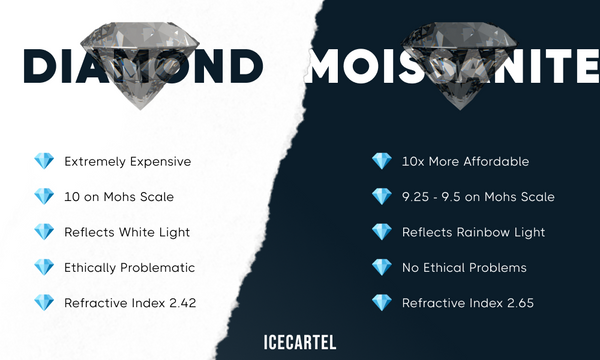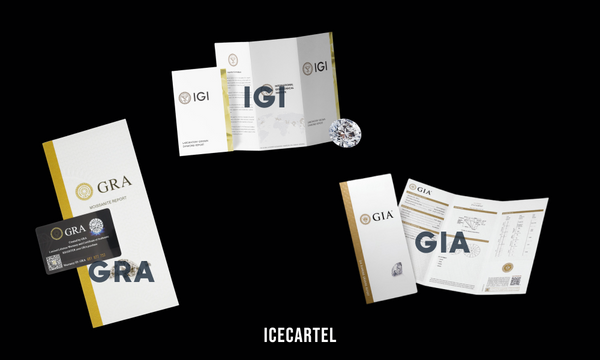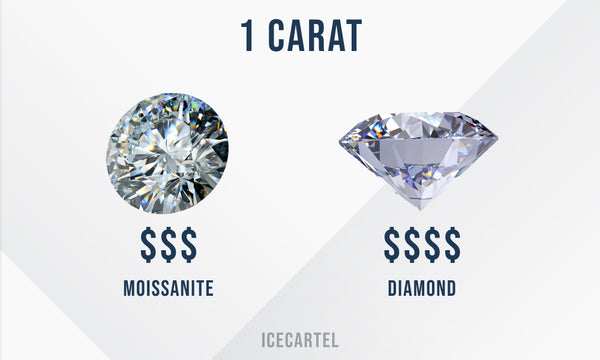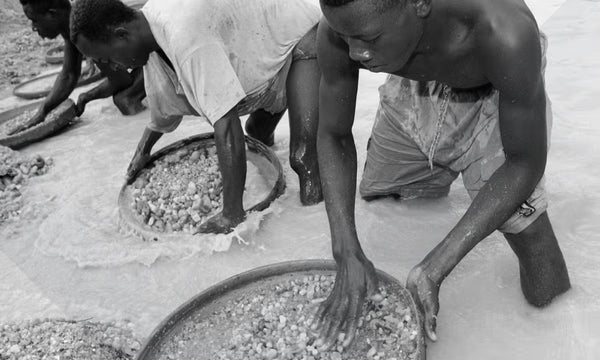Are you considering moissanite or diamonds? Unearth the truth about moissanite and how it is different or similar to diamonds with various techniques focused on their characteristics.
Exploring technical and optical properties of each unique stone offers a world of knowledge pertaining to your shopping experience and best possible outcome for your final purchase.
Choosing moissanite or diamond becomes easier with our comprehensive blog of moissanite vs diamonds: is it worth choosing moissanite over a diamond?
Moissanite vs. Diamond: Comparison Benchmarks

Looking in-depth and comparing moissanite and diamond takes extra time, painstaking thought, and technological knowledge that will assist you in selecting the best stone option when it comes time to purchasing a diamond engagement ring, or moissanite. Here are a few main factors to consider:
Production
Diamonds and moissanite are produced differently with distinct chemical compositions. Here are the differences:
Composition: Diamonds are made of pure carbon, forming in the earth's mantle over millions of years. Moissanite is composed of silicon carbide (SiC) with trace elements.
These differences in chemical composition accounts for variations in their physical and optical properties, along with crystal structure. Although moissanite and diamond may look very much alike at first glance to the untrained eye, they aren’t upon evaluation.
Availability
Moissanite: Moissanite and natural diamonds are both available for purchase in different quality and carat sizes and fashioned into common shapes for your shopping convenience. What then, is the difference?
Moissanite is a lab-grown gemstone, which allows consistent production, ensuring a constant supply of moissanite worldwide. This makes choosing your round brilliant cut loose moissanite stone and setting into any mounting, customizing a chain, or other jewelry easy because moissanite is effortlessly to obtain for both the consumer and jeweler.
Diamonds are formed deep within the Earth's crust over millions of years. Diamond occurrence may be unpredictable and may be of limited quantities in mines worldwide. The extraction of diamonds involves extensive mining and sourcing.
Neither natural diamonds or lab-grown moissanite are hard to find, purchase, or acquire, unless it is a custom made speciality design or a very rare, difficult to acquire, and costly diamond. However, it is more cost effective to choose a lab-grown moissanite than a natural diamond.
Hardness & Durability
As defined by the Gemological Institute of America (GIA), the Mohs scale rates the hardness of gems and minerals from 1-10. The Mohs scale of hardness, developed by Friedrich Mohs in 1822, is a method for assessing the scratch resistance tendencies of minerals and other objects compared to other minerals that are harder or softer.
The Mohs scale assigns a numerical value to each mineral, with higher numbers indicating greater hardness. Diamond, the hardest mineral,rates a 10, while talc, the softest mineral, has a rating of 1. Moissanite is also highly durable but rating a 9.25 out of 10, making it slightly less scratch-resistant than diamond.
Hardness should not be confused with mineral toughness. Toughness refers to a gem's ability to withstand impact, resist breaking, chipping, or cracking. While some gems may be tough, the Mohs scale rates the scratch resistance. All or most materials can be broken or damaged–nothing is indestructible.
By considering the hardness of gemstones, jewelers and gemologists are able to make appropriate use of different materials in various applications fashioned into stunning jewelry.
Gemstones with lower hardness ratings, like opals, coral, or pearls, are less scratch-resistant, requiring more delicate handling. For example, pearls and Mabe' pearls are never faceted because of their composition. Mother of pearl is frequently set into inlays like opals, onyx and other gemstones. Faceting is suitable for topaz, quartz, diamond, corundum, beryl, and moissanite, among many others.
When pondering on the hardness of moissanite vs diamond, it's important to note both gemstones are exceptionally durable compared to opals, pearls, coral, and others. Moissanite offers durability very close to a diamond at a more affordable price point, making choosing a gorgeous, high-quality piece of jewelry well within reach.
This hardness means both gemstones possess exceptional resistance to scratching and abrasion during common activities, making moissanite and diamond suitable for everyday wear.
Want to learn more about moissanite and how it compares to other stones? Check out our blog, Moissanite Hardness: Absolute Rating on Mohs Scale Explained.
Cut
Cut should not be confused with shape. Shapes include round brilliant cut, marquise cut, princess, baguette, and more. Cut refers to the symmetry of the shape.
The cut of a diamond is the most crucial aspect among the 4Cs (cut, color, clarity, and carat weight). According to GIA, The GIA 4Cs of diamond quality assists the consumer with understanding the diamond’s characteristics, value, and price when shopping for a diamond. It is a universally understood language, making the experience of selling and buying a diamond more transparent between buyer and seller.
What does cut evaluate? The cut encompasses the dimensions, proportions, and symmetry of the diamond and its shape. An excellent cut maximizes the diamond's weight and fire, showcasing its beauty. Learn more about the best moissanite cuts here.
What is an excellent cut or a poor cut? When a diamond is properly cut, it retains as much of its rough weight as possible, enhancing its visual appeal, and removes attention from imperfections. An excellent cut accentuates the diamond's carat weight, shape, and quality factors, such as fire, scintillation, and sparkle.
What are the parts of the cut stone? Here is a breakdown:
TABLE: The top portion of a diamond that is visible when looking at it from above. In a round cut, the table will have a round shape. Princess has a square shape, etc.
CROWN: The slanted area of the diamond located between the table and the girdle, positioned near the top of the stone.
GIRDLE: The girdle is the circumference of the diamond, resembling a seam where the crown and pavilion intersect. Girdles may be faceted, inscribed with serial numbers and other identifiers found inside the stone.
PAVILION: The lower portion, or "body," beneath the girdle.
CULET: The pointed facet at the bottom of the diamond.
Want to learn more about cut? Check out our other blog, The Sparkle Factor: Which Moissanite Cut Sparkles the Most?
Color Varieties
Diamonds are available in white and fancy colors, including green, brown, black, yellow, blue, and pink. Moissanite is also available in different fancy colors when it is created in a lab. Trace elements are added to the manufacturing process producing gorgeous colors. This makes both diamond and moissanite versatile. Here's a moissanite color chart:

Color: Color is graded D-Z on the color grading scale for diamonds. Sellers of moissanite have adopted this way of evaluating moissanite--just like white diamond, even though the 4Cs are for diamonds. Here is a brief breakdown.
Color Grading Scale:
- D-F: Colorless, with D being extremely rare and valuable.
- G-H: near colorless
- I-J: near colorless
- K-M: faint color
- N-R: very faint color
- S-Z: light color
Clarity
Clarity refers to the presence of internal growth characteristics and external characteristics (blemishes), naturally occuring during the formation of a diamond under high pressure.
FLAWLESS (FL): Completely free of inclusions or blemishes visible under 10X magnification. Flawless diamonds are extremely rare, highly valuable, and accompanied by a higher price tag.
INTERNALLY FLAWLESS (IF): No inclusions or blemishes visible under 10X magnification. Minor blemishes do not affect its overall appearance; IF diamonds are also expensive.
VERY, VERY SLIGHTLY INCLUDED (VVS1-VVS2): Very very minute inclusions that are difficult to detect under 10X magnification. These diamonds have exceptional clarity with inclusions often hiding behind the facets only a professional can detect.
VERY SLIGHTLY INCLUDED (VS1-VS2): Inclusions are visible under 10X magnification and have minimal impact on the diamond's appearance. VSI1-VS2 clarity diamonds are perfect for those seeking a higher clarity diamond without spending the high price of VVS.
SLIGHTLY INCLUDED (SI1-SI2): Inclusions are noticeable under 10X magnification. These diamonds offer good value for their clarity grade.
INCLUDED (I1-I2-I3): Inclusions are readily apparent under 10X magnification. These are budget-friendly diamonds. I3 clarity diamonds commonly have very visible inclusions with the naked untrained eye. These diamonds have the lowest clarity grade and are generally more affordable.
Want to learn more about moissanite jewelry? Check out our other blog, What is Moissanite Jewelry? An In-Depth Look.
Carat Weight
CARATAGE: The carat weight of a diamond determines the value of the diamond, colored stone, moissanite, and other gems, along with other quality factors taken into consideration.
Diamond vs moissanite carat weight, what is the difference when it comes to these gorgeous gems? When comparing diamond and moissanite carat weight, there are a few factors to consider:
Larger carat weights are especially rare to find. The rarity and finite supply of natural diamonds contribute to their higher value and price.
Certificates

Are you looking for moissanite jewelry or diamond jewelry with a certificate? Moissanite and diamonds are frequently accompanied by certificates providing technical information about their quality characteristics.
GIA: The Gemological Institute of America is the most widely recognized laboratory specializing in gemstones, diamonds, identifying man-made stones, enhancements/treatments, and other aspects of loose stones and jewelry. The GIA grading report details aspects of gemstones, revealing technical information on each unique piece sent for evaluation. GIA Diamond Grading Reports provide assessment of the diamond's 4Cs, as well as additional information such as fluorescence.
IGI: According to its official website, IGI grades the widest variety of gemstones and jewelry worldwide than any other gemological organization. Renowned for diamonds and colored gemstones, IGI is also equally trusted with the grading of pearls, exotic carvings, fine jewelry pieces, and modern synthetics and simulants.
PGGL: According to its official website, PGGL is a third-party gem lab that specializes in certification services for natural and lab-grown diamonds, moissanite, and other gems. It offers a variety of moissanite grading services to retailers, wholesalers, manufacturers, as well as consumers. Their moissanite grading service is used by leaders in the moissanite gem market, as well as reputable wholesalers and e-commerce retailers specializing in selling moissanite.
GRA: The Global Gemological Research Association Institute (GRA) has become a trusted and reliable source with trade professionals worldwide, relying on GRA's assessments and certifications to ensure the authenticity and quality of gemstones, most notably moissanite.
Want to learn more about GRA? Check out or blog, How to Determine If a GRA Moissanite Report is Fake?
Independent Labs: Independent labs offer certificates for all kinds of jewelry, not just diamonds and natural gemstones. Conducting research on these companies before ordering a report is beneficial for finding out if they are legitimate.
Thermal Conductivity
What is thermal conductivity? According to IGI, thermal conductivity can be defined as the ratio of the flow of heat through a given thickness of material to the temperature difference across this thickness.
There are several types of diamond testers available, each with its own attributes. Some of the common types of testers include heat, electricity, or combination testers.
Thermal conductivity testers: A thermal conductivity tester measures how quickly a material conducts heat and uses this information to determine whether a gemstone is a diamond or not. These testers are inexpensive and easy to use. However, they are not always accurate, as some diamond simulants can also conduct heat. Other tests can be used for identifying stones and diamonds.
According to The Voice UK, The thermal conductivity of moissanite is 25% greater than diamonds (3.42 vs 2.86), with double the fire dispersion of diamonds (0.104 vs 0.044), and has 16% greater luster than diamond (20.4 vs 18).
Thermal and Electrical Properties: Diamonds ability to retain heat energy and conduct electricity has made them an in-demand and useful commodity in other industries. Scientists value diamonds for their closed-shell electron structure, making them highly resistant to damage from humidity and acidity, and ideal for use in advanced electronics like spintronics.
Corrosion Resistance
Which is more corrosion resistant, diamonds or moissanite? Diamond and moissanite both exhibit exceptional resistance to corrosion, ensuring their durability and long-lasting nature when they are set into engagement rings, wedding bands, chains, pendants, custom jewelry, and more.
Why are moissanite and diamonds corrosion resistant? It is because of their high hardness on the Mohs scale. This makes them durable, resisting chipping and abrading.
Chemical Properties: According to the website, Diamonds Are Evil, since diamonds have an incredibly strong chemical bond, this makes diamonds unique in chemical composition, resisting heat and other elements that could potentially break down the stone.
Moissanite is composed of silicon carbide and is highly stable, resistant to chemical reactions with acids, bases, and other corrosive substances. Moissanite will maintain its brilliance and integrity over time, even in environments where it may come into contact with potentially damaging chemicals.
Suitable for Jewelry: Diamond and moissanite corrosion resistance makes them a brilliant selection for fine jewelry design. Both moissanite and diamond have the ability to withstand chemical exposure, including cleaning products, lotions, shampoos, oils, soaps, and cosmetics, without losing their luster or reacting to chemicals that may damage their crystal structure. This remarkable attribute of resisting corrosion allows moissanite and diamond to retain their glittering beauty and hardness/durability.
Variety of Jewelry
Are you concerned there may be limited options when it comes to designing your custom made jewelry with moissanite and feel that there may be limited options because moissanite is not as common as diamond? Here are some ideas:
Engagement Rings: Moissanite has increased in popularity over the last decade, frequently set into engagement rings featuring fine metals including all colors of gold, platinum, and silver. Choosing a moissanite engagement ring is easy–moissanite is available in different price points, set into classic and modern designs just like diamond. Have the big, bold, glamorous look you have always dreamed of with moissanite.
Stacking Rings/Wedding Bands: Have you longed for an eternity ring but worry about the price? Moissanite eternity bands exude all the elegance of a diamond eternity ring without the hefty price tag. Since moissanite is usually uniform in quality, a moissanite eternity ring is perfect for those who love a harmonious balance of fire and sparkle without inclusions.
Custom Made Jewelry: More jewelers than ever are learning how to work with moissanite as demand increases. Choosing a jeweler with experience setting moissanite will enhance your chances of customizing and creating the engagement ring and other specialized jewelry of your dreams.
Moissanite vs diamond, which is better for an engagement ring? It all comes down to personal preference, style, budget, and other considerations, completely dependent on the buyer.
Since moissanite is a high-quality, durable, and valuable simulant of natural moissanite yet provides all the brilliance and fire diamond has to offer, the options become endless as moissanite is incorporated into different fine jewelry for your selection. Want to know more about natural vs man-made moissanite? Check out our blog, Is Moissanite Man-made or Natural? Get to Know the Truth!
Price

Affordability: Moissanite is a more affordable alternative to diamonds of comparable size and quality. This makes the look you want within reach--don't compromise on size and style because of the price. Moissanite delivers all the elegance as diamond with its unique characteristics.
Demand: Diamonds have a higher demand for engagement rings and other fine jewelry designs because they have a long-standing reputation as the traditional choice. This constant demand drives up the cost for natural earth-mined diamonds as they are the most popular choice for keepsake designs.
Rarity and Availability: Diamonds must be sourced and mined from the earth, unlike moissanite which is typically a lab grown gemstone. Rarity, labor, and natural occurrence of diamonds all hike up the price of a diamond compared to the engineered moissanite.
Origins: Since the production of moissanite is a less complex than mining and extracting natural diamonds from the earth, this makes different quality and carat weight moissanite gems more available to a broader worldwide audience without the price tag of high quality, larger carat weight diamonds of equal 4Cs value.
Investment Value
Natural, earth-mined diamonds, compared to moissanite, retain a higher value over time with a higher resale value, making them a reliable investment for an engagement ring and other jewelry. Diamond rarity and long-standing cultural significance are some of the contributing factors to their perceived value and potential for appreciation over time.
Moissanite is a gorgeous, natural, earth mined diamond lab-grown alternative. Moissanite is more affordable than natural diamonds and is not a rare stone because of its synthetic origins, unlike natural moissanite, which is rare and incredibly expensive.
Moissanite can be evaluated for insurance purposes but will not have the same value as a natural diamond. Issuing a professional certificate with moissanite is suitable for resale purposes, if the item gets lost, stolen, or destroyed, a well. There IS a resale market for moissanite --it not as common as diamond and natural gemstones.
Learn more about the long-term value and qualities of this beautiful gem in our comprehensive Moissanite Guide
Ethical Considerations

Here are some factors to consider with diamonds and moissanite related to ethics and sustainability:
Ethical Sourcing: Moissanite vs diamond, which is more ethical? Moissanite is created in controlled laboratory environments. The lab process does not involve mining, avoiding potential ethical concerns such as human rights violations, harsh labor conditions, and environmental damage.
Conflict-Free: Moissanite are conflict-free since they are synthesized in a lab. Lab-grown moissanite is not associated with regions known for unethical practices that frequently accompany diamond sourcing and extraction.
Conflict-free diamonds ARE available for purchase. However, there is no guarantee and no proper guideline outline for conflict-free diamonds. They may have been called conflict free in an effort to make them more appealing without verification.
Sustainability: The production of moissanite requires energy and resources for technology, work force, and materials needed to grow the moissanite crystals. These resources and materials do not compare to the environmental impact associated with natural, earth-mined diamond and colored gemstone mining.
Can diamonds be sustainable? According to the article, Brides.com:Sustainable Diamonds: Everything You Need to Know, there are a few ways to promote sustainability with diamonds. A sustainable diamond can be defined as: A diamond that is sustainable is one that has been sourced in an ethical method, or has been created in a lab using environmentally-friendly techniques, or has been recycled and reused, reset, or resized.
Some methods of incorporating sustainable diamonds include:
Reusing and resetting used diamonds (heirloom keepsakes–using grandma’s old ring!), carbon-free diamonds.
Choosing lab-grown diamonds instead of natural diamonds. Lab-grown diamonds have the same origin as lab-grown moissanite–engineered in the lab without disruption to the environment.
Can Moissanite Be Compared to Diamond?
Here are some ways moissanite vs diamond stack up:
Origin: Natural moissanite was discovered in Arizona in 1893 by French chemist Henri Moissan, later named moissanite. Charles & Colvard, a gemstone and jewelry manufacturer, pioneered the production of synthetic moissanite in the 1990s because natural moissanite is so rare, introducing lab-grown moissanite to the market. Soon moissanite rose in popularity, providing a brilliantly beautiful, high-quality, and sustainable alternative to natural moissanite, natural diamonds, and mined gemstones.
Brilliance and Fire: Did you know moissanite is the most brilliant stone on earth?
The Refractive Index is a scale used to measure the behavior of light passing through minerals. Moissanite exhibits a refractive index ranging from 2.648 to 2.691. Moissanite displays a dispersion of 0.104, contributing to its remarkable ability to separate white light into its spectral colors.
Dispersion refers to the way that different colors of light are refracted at different angles by a mineral. These characteristics, combined with its adamantine luster and noticeable double refractivity, give moissanite a brilliant appearance. Diamonds have a timeless elegance, displaying their icy-white classic sparkle and brilliance.
Thermal conductivity diamond vs moissanite: Can moissanite pass the diamond tester? As mentioned above, thermal conductivity testers are devices designed to assess the speed at which a material conducts heat, commonly used for determining if a gemstone is a diamond or a diamond simulant. However, testing for thermal conductivity is just one of the steps used for gemstone and diamond identification. Moissanite can pass some of the diamond testers, which makes choosing the correct tester and other methods of identification important.
Conclusion
Diamond vs moissanite, which is the better option? Here were a few topics covered in this article:
Hardness: Moissanite is one of the hardest gemstones available–although diamond is slightly harder. Moissanite's hardness ensures its ability to withstand daily activities, maintaining its brilliance as long as it is regularly cleaned and routinely taken care of at home and by a jewelry professional. Moissanite's hardness rating makes it a practical selection for engagement rings, wedding bands, custom jewelry, chains, pendants, bracelets, and other fine jewelry pieces.
Want more information about how to care for your moissanite jewelry? Check out our other blog, How to Clean Moissanite Ring: 7 Tips to Keep Moissanite Brilliant.
Brilliance & Fire: Moissanite exhibits a higher refractive index than diamonds, giving it a spectacular rainbow "disco ball" effect, creating vibrant flashes of color as it glistens in any setting.
Socially Conscious: Feel good wearing your moissanite because of its lab-grown origins without compromising on personal values and preferences frequently associated with sourcing diamonds.
Sustainability has become an important topic pertaining to sourcing diamonds and other gemstones. Lab-grown moissanite does not disrupt the environment and is considered environmentally friendly because it is created in a lab.
Quality: Lab-grown moissanite is a high-quality diamond alternative–it is not a cheap knock off of a diamond but a replication of natural moissanite, a naturally rare stone found in meteorites . It is hard, durable, beautiful, and brilliant, designed to last a lifetime and beyond through wear and tear.
Eco-Friendly: Conflict-diamonds include safe working conditions and fair pay with minimal impact on the environment and ecosystem through mining and sourcing the stone. Although companies may sell ethical diamonds or conflict-free diamonds, there is no way to verify the information provided.


































































